|
The Early Phonographic Craze in Ontario, 1878-92
by Arthur E. Zimmerman
Recording a voice on an Edison-licensed hand-driven variant of the tin-foil phonograph, c. 1878
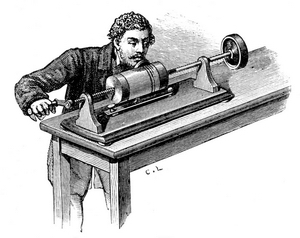
|
|
The original intention of this article was to document the collection of 30-odd wonderful and unique brown wax cylinders, rescued by Paul Dodington back in the mid-1960s (1). This seemed a good opportunity to also look back at the showings of the tin-foil phonograph in Ontario, with a cursory and anecdotal account of the evolution of the phonographic cylinder technology by Thomas A. Edison.
From the earliest years of the phonograph, there were many independent entrepreneurs travelling around Ontario giving public demonstrations of Edison's marvelous invention, at first the tin-foil phonograph and later playing early commercial wax cylinders and recording local talent, to astonish them and their neighbours. With a few exceptions, the tinfoil sheets are gone, but a few collections of the fragile home-made brown wax cylinders of the early 1890s have survived and are still playable.
Early Exhibitions of Edison's Tin-Foil Phonograph
On February 14, 2008, Brent Scollie e-mailed the author, citing an article in The Thunder Bay Sentinel (2), about an entertainment by Roy Alphonse, involving invisible wire-walking, barrel-tossing, along with singing and recitations from the phonograph. In 1879, this phonograph would have been a copy of Edison's tin-foil-playing instrument.
The Thunder Bay Public Library was kind enough to forward a scan of that article and an on-line search of the Library of Congress (LoC) newspaper database yielded an article from St. Paul. Mn., about an exhibition at Highland Park of invisible wire-walking and barrel-dancing by Mr. Roy Alphonse, varied by selections by the Great Union Band, but no mention of a phonograph (3). Further searches in the LoC database brought up other phonograph demonstrations in St. Paul in 1879 (4) and two earlier ones (5) and three later in 1878 (6).
The exhibition of a phonograph in St. Paul on Dec. 1, 1878, was by C.H. Cobb, and a search of the "Hotel Arrivals" in Thunder Bay of a year earlier, listed in The Thunder Bay Sentinel (2), showed Mr. Roy Alphonse of Ottawa and Mr. W.H. Cobb staying at the Pacific, in preparation for their exhibitions at Thunder Bay. It must have been a wonkily scribbled "C" in the hotel register or by the newspaper reporter, interpreted as a "W", because phonographist C.H. Cobb was actually the man who brought the tin-foil phonograph to Thunder Bay in July, 1879. Capt. Charles H. Cobb (b. Massachusetts, 1840 - d. Montana 1926), "the enterprising phonograph man" (7), had enlisted in the Union Forces in April, 1861, was wounded at the Battle of Antietam in 1862 and was mustered out in 1863 (8). In the late 1870s, he was an entertainment officer of the G.A.R. of Minnesota and worked for The St. Paul Dispatch.
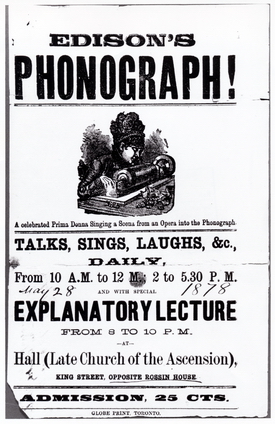
|
Poster advertising a phonograph exhibition of Edison's new tin-foil phonograph in Toronto on May 28, 1878.
Paul Dodington identified the "Celebrated Prima Donna" as French soprano Marie Roze (nee Hippolyte Ponsin, 1846-1926), later Mrs. Henry Mapleson, who reportedly turned down the
title role in the premiere of Bizet’s "Carmen". The engraving was made for Frank Leslie's Illustrated Newspaper (New York City, April 20, 1878) after a demonstration of the machine at
Steinway Hall in early 1878. The engraving was also used on the early sheet music "The Phonograph March Brillante" and on tickets to phonograph exhibitions.
|
|
Edison's phonograph agents turned up in Canada in the late spring of 1878, just a few months after the invention, giving public demonstrations of the tin-foil "Speaking Phonograph" in large halls at 25˘ a head. Messrs. Orson G. McCall and George U. Danforth of New York were the agents in a tour of Ontario, while J.E. Gove had the contract for Quebec.
Bill Pratt pointed out that a poster with Marie Roze singing into a tin-foil phonograph, shown in his first newsletter of the Antique Phonograph Society of January, 1982 (9), was used for a phonograph exhibition in Toronto, at the Hall (late Church of the Ascension) on the south-west corner of King and York Streets opposite the Rossin House, on May 28, 1878 (as hand-written on the flyer). There would be an explanatory lecture and the machine would be shown to talk, sing and laugh, etc. Bill quoted Gelatt "It would talk in English, Dutch, French, German, Spanish and Hebrew. It would imitate the barking of dogs and the crowing of cocks. It could be made to catch cold and cough and sneeze so believably that physicians in the audience would instinctively begin to write prescriptions" (10).
In fact, the initial lecture-demonstration took place on Thursday, May 16, 1878 at the place and hours specified in the flyer (11) and demonstrations continued through May 31. The phonograph was also shown to Lord Dufferin at Rideau Hall, Ottawa, on May 17, 1878 (12), and to the public in June at Pronguey's Hall on James Street in Hamilton (13), under the charge of "manager" Mr. McCall.
Knox College, on the Toronto university campus, held a "Conversation" in June, 1880, with a diversified program for the evening, including the exhibition of a phonograph (14), certainly a tin-foil at this date but with an unknown operator.
White Wax Cylinders, 1888-92
Four gentlemen recording a voice on a Grenet cell-powered NAPC Class M Phonograph, using white wax cylinders and a speaking tube, Paris, 1889
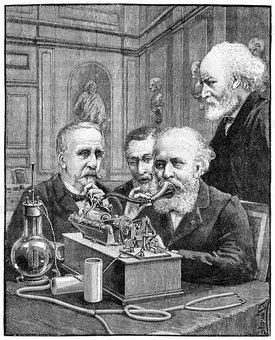
|
|
The public quickly tired of the fragile, ephemeral tin-foil strips which tore easily and could not be re-mounted on the grooved mandrel for re-playing. An idea to make plaster-cast stereotypes of the flimsy tin-foils for mass pressings and then of pressable copper-foil flat discs or "phonets" came to nothing (15). Almost a decade later, Bell and Tainter developed a hard wax-coated cardboard cylinder for their Graphophone, but that technology was quickly superseded by Edison's "Perfected Phonograph" in May, 1888, using white, all-wax cylinders. Initially, these were made of ceresin, beeswax and stearic acid, but then he turned to metallic soaps (salts of fatty acids) which are harder. Edison sent his new phonographs and agents around Europe to impress the crowned heads and celebrities, and the story hit the press after Edison received white wax phonograms from his agent in Britain, Col. Gouraud, of the recorded voices of Gladstone, Balfour and other British celebrities (16). Amazingly, many of those very early white waxes still exist and are playable. The earliest was a series of snippets recorded at the Handel Festival on June 29, 1888, at the Crystal Palace, London. White wax recordings have also survived of the voices of Sir Arthur Sullivan, Phineas T. Barnum, Florence Nightingale, Alfred Lord Tennyson (17), Robert Browning, W.E. Gladstone (18), Prince Otto von Bismarck, Helmut von Moltke, Lord Frederick Arthur Stanley of Preston and of trumpeter Martin Leonard Landfried of the Light Brigade. A cylinder was taken of Johannes Brahms at the piano and cylinders of several of the voices of other musicians, politicians and officials, plus the wonderful cylinders in the Julius Block collection (19). There was also a report of part of an 1888 concert in Boston conducted by Hans von Bulow, but it's never been found. A Graphophone cylinder of the voice of Queen Victoria may have surfaced (20). Edison talked of recording Mark Twain but said (without proof) that those cylinders were destroyed in the factory fire at Orange in 1914 (21).
Phonograph versus Graphophone
About that time, likely by 1885, Edison had lost interest in his phonograph, working on his light bulb (pat'd 1880) and then developing his electrical distribution system. Taking ideas from Edison's more detailed English phonograph patents, Bell and Tainter developed a 6 x 1.3 - inch recordable, removable cardboard cylinder coated with a thin layer of hard ozocerite mineral wax (22). Their Volta Graphophone Company's machine held the narrow cylinder with spring-loaded shoulders, rather than with a mandrel (23). This development got Edison going again and, in October, 1887, he created a new Edison Phonograph Company, with rights to manufacture. On May 19, 1888, he unveiled a machine with all of the new improvements, the battery-driven "Perfected Phonograph", using 4 3/16 - inch white, all-wax cylinders. In 1888, Jesse H. Lippincott had secured the rights to sell Graphophones and, after negotiations, in late spring Edison agreed to sell all of his phonographic stock to Lippincott, reserving the right to manufacture machines and musical phonograms. Now Lippincott's North American Phonograph Company (NAPC) had control of both major talking machines, to be treated equally, both to be leased for business purposes on the model of Bell's telephone. Lippincott did this by contracting agents on a state-by-state territorial basis, the Holland Brothers of Ottawa to be the agents of British North America and Alaska.
George A. McClellan, general manager of the State Phonograph Company of Illinois, came to Ottawa in May of 1890 to introduce the Edison Phonograph. It could "economize the time of the business man....all the largest firms in Chicago have them in use at present.....A business man can come to his office and find a stack of letters demanding his attention. With one of these little instruments, he can take up each letter, read it, and at once talk a reply upon the cylinder - avoiding a second handling of the letter - thus economizing his own time, and saving that of a stenographer....." (24). As well, dozens of U.S. congressmen were using Phonographs in their offices (25). The Phonograph was also adopted for stenographic matters by the Canadian Parliament in Ottawa. A phonographic letter, a phonogram, was delivered to Parliament, addressed "Holland Brothers, Edison agent", and was delayed for duty payment of two cents (26).
After a few years waiting, Mark Twain was able to rent two phonographs through Edison in 1891 to aid in his writing of "The American Claimant" but, after filling four dozen cylinders for transcription, concluded that he could have done better with pen and paper (21).
A man dictating into a Graphophone, c. 1889
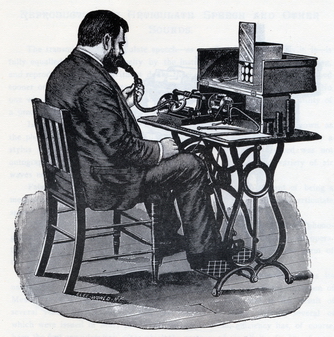
|
|
A woman transcribing from a modified Phonograph-Graphophone,
with horn to ear, from The Phonogram, 3 #2 Feb. 1893
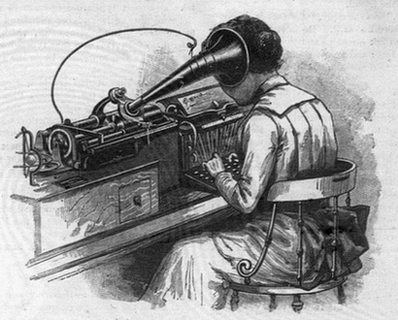
|
|
Graphophones were also used in the U.S. House of Representatives, where stenographers scrambled to make notes in the chaos of debating and shouting, then went down to the transcribing room to read their notes into the talking-machine, for later typing out (27). The press also featured testimony of a gentleman who used his Graphophone at home to take dictation, the cover being half the size of a sewing machine, "It takes up no room and is always ready to take dictation" (28). Another opined that the Graphophone was simpler in construction and an improvement on the Phonograph (29).
Despite the accolades in the press, sales of the Graphophone were slumping. Stock offerings were unsuccessful, deliveries of both machines were slow and they broke down a lot, so local agents pressed NAPC to combine the best features of the Phonograph and the Graphophone (now termed the Phonograph-Graphophone), giving rise to the First Annual Convention of Local Phonograph Companies of the U.S.A., held in the Auditorium Hotel, Chicago, May 28 and 29, 1890 (30). The proceedings were to be secret, but a squib leaked, published in The Northern Advance, Barrie, Ontario, (31). In a series of tests "....the Phonograph showed superior qualities of recording and reproducing, and indicated far greater sensitiveness to sound than the Graphophone....(this) seemed to point to a new era in verbatim reporting".
By early 1894, NAPC was insolvent, Lippincott was incapacitated and Edison resigned as president of NAPC because of a tangle of patent- and delivery-suits among his companies. Edison tried to round up and pay off the bond- and patent-holders of NAPC, though the Edison Works was still producing both types of machines for sale. He then declared bankruptcy for both NAPC and his Phonograph Works and, on August 13, 1894, Edison sold his stock in the Edison Phonograph Company. When those shares came up on public auction on March 15, 1895, he bought them back, thus regaining his phonograph patents, inventory and contracts, and could continue in manufacturing and sales (23).
About that time, the Volta Graphophone Company sued Edison for infringement of patents and Edison counter-sued. Actually, by then Bell/Tainter had had no new patents on their Graphophone for eight years, while Edison had many dozens. The matter of infringement on the Phonograph and Graphophone patents was decided first in another jurisdiction, in the High Court of Chancery in Britain. Based on the much more detailed British patents, Justices Kennedy and Gray ruled in favour of the Edison Phonograph Company on all points and all claims were sustained (32). The American-based suit was not resolved until July 1896, with a modest cash settlement by Edison for damages and costs (33).
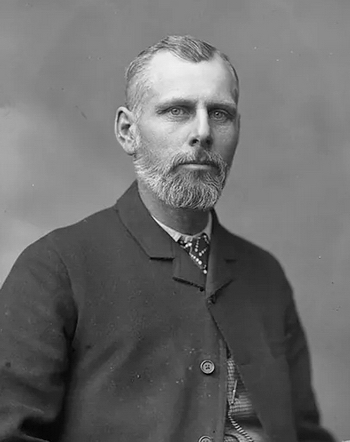
|
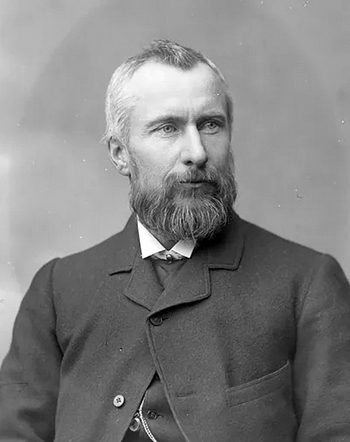
|
|
Andrew Holland (1844- 19??)
|
George Holland (1846-1923)
|
|
The Holland Brothers, an agency of parliamentary reporting, owned The Ottawa Daily Citizen from 1873, were the official reporters for the Senate of Canada from 1876, general agents for the NAPC for British North America and Alaska from 1891, and handled Smith-Premier typewriters as well.
|
|
The Holland Brothers of Ottawa
An agency of parliamentary reporters, the Holland Brothers had been the official reporters of the Canadian Senate since 1876 (34) and in 1888 tried to buy two NAPC machines, but NAPC would lease only; before there was a Canadian agent, selling or leasing to Canada would have violated the Canadian patent. The Hollands eventually induced the Dominion Printing Bureau to obtain two machines and the Bureau sold one to them for experimenting. The idea was to record notes of Senate proceedings (at low speed they could get 800-900 words on a cylinder) (35) and send the cylinders to the Bureau linotypist for printing (36) but that did not work out. Instead, the cylinders had to go to a typist first, for transcription. Besides, the Senate would not allow machines into the Red Chamber. Later, two Phonographs in the Department of the Interior, Ottawa, were used for dictation of letters, from office to office, the message then typed out and the cylinder pared off for re-use (37). And the Hollands noted that the phonograph was excellent for court reporting (38).
George Holland tried a Graphophone too, since it was lighter and less fragile, but the reproduction was less distinct (ibid.) He observed that using a speaking tube was preferable to a small horn for recording for a typist to transcribe (35).
Holland Brothers, Bill of Sale, 1892
Found in Paul Dodington's Class M, bill of sale, showing a Class M and reading:
"Ottawa, Jan. 21st, 1892.
Sold to W.A. Holmes, Warkworth, Ont.
To 1 Dozen No. 1 Blanks $4. Packing 25 cents, C.O.D. $4.25 and return charges".
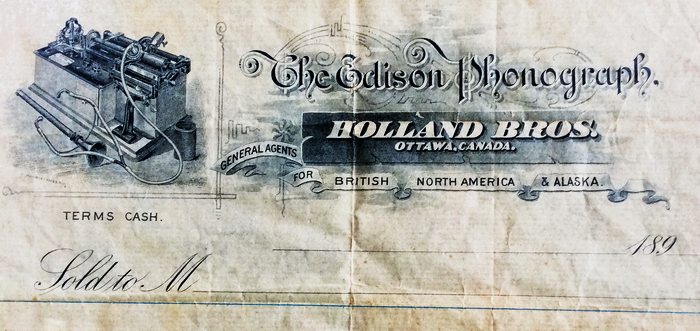
|
|
As of December 4, 1890, the NAPC local sub-companies were given the option to either lease or sell phonographs (39; 8). In 1891, the Holland Brothers at 106 Queen Street in Ottawa were appointed NAPC general agents for British North America and Alaska (40; 41), handling the Class M, built by the Edison Phonograph Works in Orange, N.J. Since the Holland Brothers' territory was so vast and unwieldy, they sold the Class M phonographs outright. That is why the Canadian-based machines were not re-called for scrapping in 1893 when the NAPC collapsed (1).
Between July 1891, and June 20, 1892, the Holland Brothers sold 123 machines (42). NAPC and Edison announced in Circular Letter #16 on January 17, 1890, the creation of a catalog of brown wax phonogram recordings that were available for sale (43). In those days, before cylinders could be mass-produced by moulding, stock for the catalog could be maintained by dubbing the master onto brown wax blanks using a pantographic device. Soft masters could last about 100+ plays, for 100+ copies, before signs of damage.
Edison Brown Wax Cylinders
Edison's harder brown wax cylinders (1892-1902) were made in a high-temperature process involving stearic acid, sodium stearate, aluminum stearate and ceresin (22). As well as playing Edison-type musical phonogram cylinders on the NAPC Class M Phonograph, one could buy blanks for recording on that machine or could shave down recorded cylinders to yield new blanks.
In the early 1890s, there were several phonograph exhibitors travelling around southern Ontario, giving demonstrations to the public, as there also were all over North America.
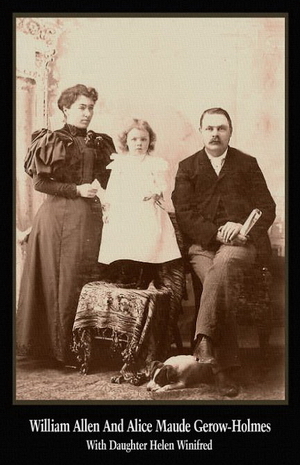
|
Travelling Phonograph Entrepreneur William Allen Holmes (1859 - 1906) of Warkworth. Ontario. Married Alice Maude Gerow (1865-1936), daughter Helen Winifred, born c. 1892. Originally a carriage maker and house painter, he obtained a NAPC Class M Phonograph c. late 1891 and, with a supply of early commercial cylinder recordings and dozens of brown wax blanks, he had a travelling phonograph demonstration business. His Class M machine and surviving brown wax cylinders were bought by Paul Dodington in 1966.
Research and photograph courtesy of Patrick Muldoon, Branch Supervisor, Warkworth Public Library, Trent Hills, Northumberland, (Nov. 10, 2021)
|
|
Paul Dodington bought his Class M in 1966, through Barnum House Museum, near Grafton, Ontario, from a Miss Nell Ewing, probably a niece of the original owner, Mr. William Allen Holmes (1859-1906) of Warkworth, Ontario (44). This machine, mostly in pristine condition, was driven by a 2.5 volt D.C. electric motor (1) and came with about 30 surviving brown wax cylinders, both commercial and home-made.
Mr. Holmes of Warkworth, Ontario, may have bought the Class M phonograph from Holland Brothers around the same time as he purchased from them a box of 12 No. 1 brown wax blanks for $4.00 plus $0.25 packing, on January 21, 1892 (1).
The April 16, 1892 Globe article (41) on the Holland Brothers continued, "Though it is but eight months since Edison's wonderful invention was introduced into Canada, it has found its way to every part of the Dominion...shrewd business men have discovered that it can be utilized to save time and labour, and ensure accuracy in correspondence....the most experienced stenographer cannot compete with the phonograph in receiving rapid dictation, it repeats what it has recorded with unerring fidelity, and at a speed to suit the operator.... a faithful little secretary to record his words at any hour of the day or night, and in such a shape that transcripts of his dictation can be made at any time. An instrument which can be employed to save time and labour in business correspondence and to instruct and amuse in the home circle, must rapidly find its way into general use".
Cylinder Program by W.A. Holmes of Warkworth
With the Class M rescued by Paul, were 30-odd surviving recordings of the 48 that he originally saw at Barnum House in 1961. Paul noted that "Some of the earliest commercial cylinders (1890-91) have spoken announcements which give the actual recording dates. Some others have thin printed paper titles pressed into a shallow groove on one end, naming the title and artist" (1; 45).
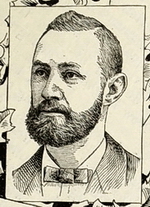
|
|
Edward Issler
|
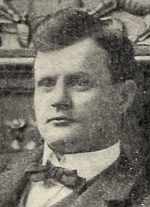
|
|
George J. Gaskin
|
|
Most of the surviving brown waxes in the Holmes collection were very early commercial releases by companies in the United States, such as:
- "For the benefit of the audience, The United States Marine Band will play the following piece entitled 'Major Perkins' March'. (Record taken for the Columbia Phonograph Company of Washington, D.C." © 1893)
- "West Point Galop" with bugle calls by Issler's (4-part) Orchestra. (Edward Issler - piano)
- "The Song That Breaks My Heart" sung by choirmaster / pastor Mr. Baltus P. Stout (1860-1935) with Issler's Orchestra (Oct. 21, 1891), with applause at end
- "Hanna Maria" by Mr. Baltus P. Stout and Issler's Orchestra, at Orange (Oct. 21, 1891) - shouting and applause at end
- "Sweet Katie Connor" sung by George J. Gaskin (The Silver-Voice Irish Tenor), and "Go Ahead" by Issler at the piano (June 2, 1891)
- "Going Back to Dixie" sung by (Gaskin's) Manhansett Quartet, at Orange, N.J. (Sept. 29, 1891)
- "Drill Ye Tarriers, Drill" by George J. Gaskin (The Irish Delight), accompanied by Issler at the piano , recorded at Orange, N.J. (Aug. 3, 1891)
- "Slide, Kelly, Slide" sung by George J. Gaskin, accompanied by Issler at the piano, recorded at Orange, N.J. (Aug. 3, 1891)
- "Who's dat a-calling" by band with cornet solos by virtuoso and march composer W.S. Mygrant
- "The Whistling Coon" by George W. Johnson, "The Ragtime Ephemerist"; born a slave and the first Black musician to record (NAPC, recorded at Orange, N.J., June 1, 1891; see ARSC Journal, 35 #1, spring 2004, pp. 37-89)
- "Laughing Song" by George W. Johnson (NAPC, recorded at Orange, N.J., June 1, 1891)
- "Haul the Woodpile Down" and "Black Pickaninny" by banjoist Charles A. Asbury (1856-1903) of New York City
- "Come Back to Children and Me", sung by Mr. Ben R. Cook with piano (possibly Mar. 2, 1892)
Note that some of the dates were taken by Paul Dodington from Allen Koenigsberg's "Edison Cylinder Records, 1889-1912" (1969). The Gaskin and Issler recordings were made at the Edison Phonograph Works in Orange, N.J., the Columbias in Washington, D.C., and the New York recordings were taken by an unidentified company.
The Citizens' Band of Picton, Ontario
In 1888, the Picton Citizens' Band had 21 members. In this 1889 photograph, they are smartly uniformed and with their sponsor, Picton merchant G.M. Farrington, in top hat. Farrington would sometimes march ahead of the band, sporting a straw hat and carrying a cane.
Photograph by Picton photographer W.F. Johnson, dated June 26, 1889. Courtesy of County of Prince Edward Library and Archives
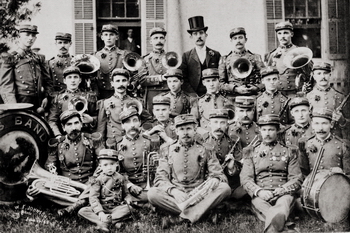
|
|
W.H. McVey and the Smith's Falls Band
William H. McVey, possibly Ontario-born, c. 1862, age 29, cornetist and bandmaster of the Smith's Falls Band, is fifth from the left. In the 1881 Canada Census, McVey may have been listed in Ward 4, Hamilton, living with his widowed mother Isabella, and brother Hugh, when William was working as a mailman. Biography & photo (Merrickville, 1894). Courtesy of Sherry Brydon, Local History & Genealogy, Smith's Falls Public Library
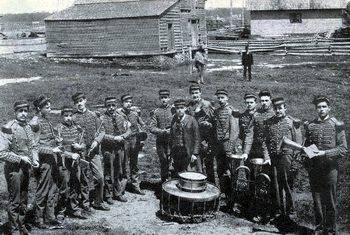
|
|
The nine cylinders in the collection that sound as if they were home-made on Mr. Holmes' Class M machine are:
- "Dancing on the Pier", played by the Citizens' Band of Picton, Ontario. The band was formed in the 1880s and was finally disbanded after WW II. As well as participating in ceremonies, celebrations and parades, the band played on steamboat excursions to Kingston, and to Watertown and Alexandria Bay, New York. They would also appear on the pier, serenading excursioners returning to Picton harbour (see Alan R. Capon in Picton Gazette, Dec. 14, 2001).
- "Cornet Solo", played by W.H. McVey, with piano accompaniment (with a false start)
- "I've Worked Eight Hours This Day", sung by Mr. W.E. Ramsay (1864-1931) of Toronto. Actor and in operetta in Toronto, and then in the U.S. As "Allan" Ramsay, he was producer/director of Thomas Edison's "Kinetophones", 1912-13, the first almost successful talkie films, and he starred in "The Introductory Lecture" and two early films (now lost). His piano accompanist may have been his wife, Asenath Fowler Ramsay (1868-1957). See (see (47), APN, Sept.- Oct. 2007)
|

|
Dancing on the Pier (2:16)
played by the Citizens' Band of Picton, Ontario
|

|
This is 'Little Britches' (2:29)
a recitation by unknown person
|

|
Cornet Solo (2:52)
played by W.H. McVey
|

|
Teaching McFadden to Waltz (2:52)
sung by V.G. Cornwell
|

|
I've Worked Eight Hours this Day (2:57)
sung by Mr. W.E. Ramsay of Toronto
|

|
Unidentified Brass Band 1 (2:15)
a march
|

|
He Never Came Back (2:45)
sung by James W.(?) Johnson of Westvale or Westville
|

|
Unidentified Brass Band 2 (3:16)
"One, two, three, four"
|

|
McCarthy's Mare (2:32)
sung by unidentified baritone with piano
|
|
|
|
|
- "He Never Came Back", sung by James W.(?) Johnson of Westvale or Westville (with false start). There are two James W. Johnsons in the 1891 Canada Census: a U.S.-born farmer, age 62 of Bothwell, Camden, near Kitchener, about 64 km from London, Ontario. His isn't a young voice, so is probably not Ontario-born farmer of 19, from Hastings North, near Bancroft.
- "McCarthy's Mare", sung by unidentified baritone with piano; traditional comic song of revelers on the way to the fair, the horse bolted, everyone knocked to the ground and the horse ran away with the cart
- "This is 'Little Britches'", a recitation by unknown person, - poem by John Hay (1838-1905), probably published in rural newspapers (46). Also recited by Hank Snow on his LP record "Doc Brown and Other Recitations", 1955
- "Teaching McFadden to Waltz", sung by V.G. Cornwell (voice cracks), possibly Vincent Cornwell, master tailor of Colborne, Ontario, widower, born England, Feb. 3, 1852, the song by M.F. Carey, sheet music published by Ted Snyder, N.Y. , 1890
- Two unidentified brass bands; one of a march and the other where the conductor can be heard bellowing "One, two, three, four" partway through the record
Cylinders on a "Phonographic Programme" flyer, c. 1892-93, of Hopper & Rayson, Cookstown, Ontario
Flyer courtesy of Paul Dodington
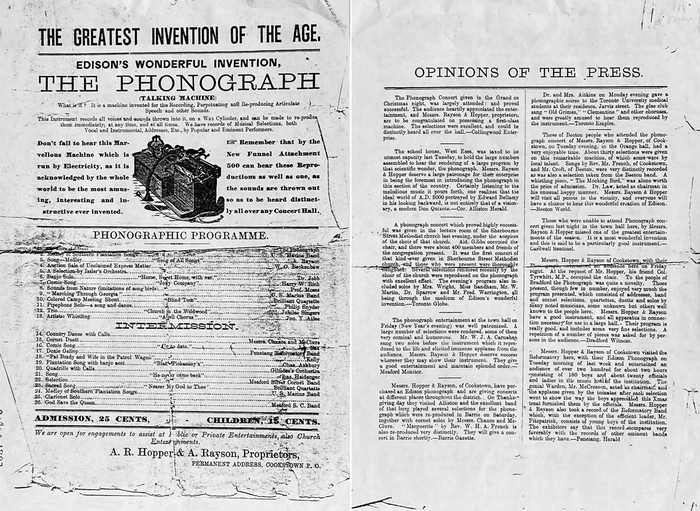
|
|
Cylinder Program of Allan Robert Hopper and A. Rayson of Cookstown, Ontario
Someone gave Paul Dodington a formal flyer, promoting the Class M with "....the new Funnel Attachment - 500 can hear these Reproductions as well as one, as the sounds are thrown out so as to be heard distinctly all over any Concert Hall", and itemizing a phonographic program of 26 cylinders presented by A.R. Hopper and A. Rayson, Proprietors, of Cookstown, Ontario. Admission was 25c, children 15c, and they were "open for engagements at Public or Private Entertainments, also Church Entertainments". The cylinders, which may have disappeared, included recordings by the U.S. Marine Band, the Jubilee Singers, Charles Asbury (banjo), the Brilliant Quartet, but also by the Penetang Reformatory Band, the Meaford Silver Cornet Band, by A. Rayson himself, by a Dr. Jebb, (banjo), by a Prof. Moses and a "Piperphone solo" by Philip Snyder, possibly a farmer, of Addington or of Waterloo South. Also one by Harry W. Rich singing the comic song "Jolly Company". Harry Rich was the vaudeville partner of W.E. Ramsay in Toronto (47).
The Meaford Silver Cornet Band
Photographed in 1887
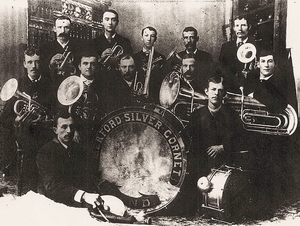
|
|
The back of the flyer lists undated opinions from the press of the Hopper and Rayson presentations:
- Christmas night at the Grand, Collingwood Enterprise
- the schoolhouse, West Essa, Alliston Herald
- New Year's Eve at Meaford Town Hall, where Mr. W.A. Carnahan sang and was recorded - Meaford Monitor
- Thanksgiving Day at Alliston, recorded the town band and Messrs. Chance and McClure, cornet solos; Rev. W.H. A. French of Cookstown sang "Marguerite" - Barrie Gazette
- Orange Hall, Beaton, recorded the Beaton Band and Rev. Mr. French of Cookstown & Mr. Croft of Beaton - Beaton World
- Town Hall, Cardwell Sentinel
- Bradford, Bradford Witness
- Christmas treat at Penetang Reformatory, recorded the Penetang Reformatory Band of young boys of the institution, directed by Mr. Fitzpatrick - Penetang Herald
From other sources:
- "Messrs. Rayson and Harper (sic.) phonographic entertainment for Temperance Hall last Wednesday was not given, owing to an outbreak of diphtheria". They promised to visit the village at a future date (48).
- "Messrs. Hopper and Rayson of Cookstown have been astonishing the Lefroy folk by the revelations of Edison's phonograph" (49).
Allan Robert Hopper in the 1891 Canada Census was a clerk in his 32 year-old brother David's shop in Simcoe South, Tecumseh, single, age 27. Cookstown is in Simcoe South.
In the 1901 Canada Census, an Alban (sic.) R. Hopper, operated an agriculture machine warehouse in Alameda, Assiniboine, The Territories (now Saskatchewan), age 36, born in Ontario on February 3, 1865. He was married to Marguerite and there was a son, George H, age 3. Brother David, born March 22, 1858, also a machinist, lived there too (50).
Research colleague Rob Gilmore (NB Archives, retired) has found A. Rayson in the 1871 Ontario Census and in his marriage and obituary records, as Addison James or James Addison Rayson (b. Alliston 1967- d. Lindsay, 1953). He was a druggist in Cookstown in the period of the phonographic partnership and later a druggist and news agent in Toronto".
The Sullivan Brothers, Travelling Phonograph Exhibitors
Brothers M.C and M.J. Sullivan, formerly an engineer with the Edison General Electric Company and of that company's legal and advertising departments, respectively, organized their phonograph exhibition business and, between 1889 and 1891, gave some 300 phonograph concerts in halls and churches in the New York City area, with their Edison "Improved Phonograph". They gathered a wide variety of the earliest commercial cylinders for exhibition, plus recordings of interested patrons made on their white wax blanks, all leavened by M.J.'s 'quaint humour'.
(The Phonogram 3 #2, pp. 322-325, Feb. 1893)
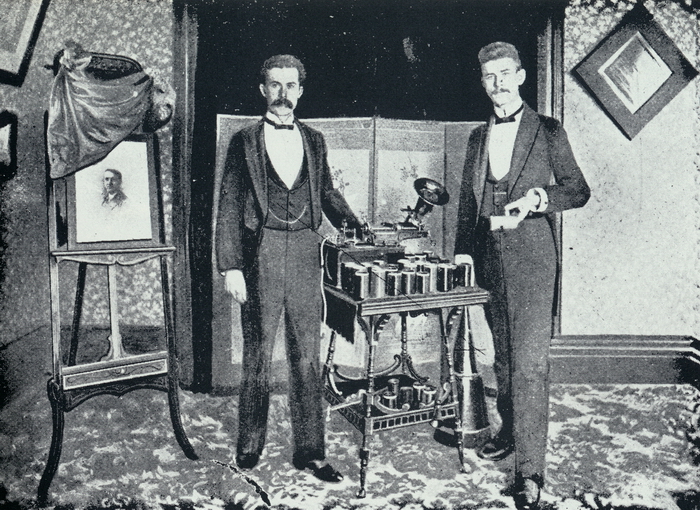
|
|
Phonographs Exhibited in Ontario, From Newspapers, 1888-92
- Edison's "Perfected Phonograph" was shown at the Toronto Industrial Exhibition in 1888 (51).
- Edison's phonograph was exhibited at Toronto's 13th annual exhibition, from Tuesday, September 8, 1891 (52).
- Phonograph at Collingwood's Great Northern Exhibition in 1891 (53)
- Phonographic concert, Monday evening by Dr. and Mrs, Aikins to the University of Toronto medical students at their residence on Jarvis Street - Toronto Empire - the well-known Dr. William Thomas Aikins (1822-1897) Professor of Medicine, 280 Jarvis Street (54)
Dr. William Thomas Aikins
(1822-1897) lecturer, clinician and senior administrator, University of Toronto School of Medicine.
(Dictionary of Canadian Biography, 12, 1891-1900)
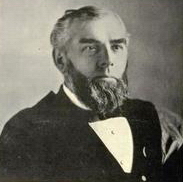
|
|
- A phonographic concert was given at Cookstown on Monday, November 30, 1891 (55), possibly by Hopper and Rayson of Cookstown.
- A phonograph was provided by the firm of Duthie & Sons when employees dined at Harry Webb's in January, 1892 (56).
- Prof. C.A. Dyke will give a course of phrenological lectures at the Y.M.C.A. Hall next Monday night "varied by an exhibition of Edison's phonograph" (57)). "Prof. Dyke was at Forest Home Presbyterian Church last Friday (April 1, 1892) with his phonograph" (58).
- Elm Street Methodist Church, Toronto, had a phonograph at their Conversation (59).
- A grand phonographic concert to be given in the Methodist Church, Barrie, Friday evening, December 10, 1892 (60)
- It is not clear from the press release (61) who brought a phonograph to the Sherbourne Street Methodist Church on December 23, 1892. Alderman Gibb occupied the chair and 400 were in attendance. " Several selections rendered recently by the choir of the church were reproduced on the phonograph with excellent effect. Also solos by Mrs. Wright, Miss Sandham, Mr. W. Martin, Dr. Sparrow and Mr, Fred Warrington, all being through the medium of Edison's wonderful invention". (Dr. Malcolm Weethee Sparrow (b. Athens, Ohio, Aug. 11, 1862 - July 11, 1936) dentist, concert singer, poet, novelist, wrote "The Queen's Volunteers". Mr. Fred Warrington, (b. England, 1852), studied in Boston and New York, directed Elm Street Choir then to Sherbourne Methodist, popular baritone, teacher at Metropolitan College of Music.)
Black Waxes to Blue Amberols
Edison introduced two-minute, hard wax black cylinders in 1902 to replace the softer brown waxes of circa 1892-1902, which could not easily tolerate more than 100+ plays. Again, the synthetic process involved high-temperature reactions among sodium carbonate, sodium hydroxide, aluminum, stearic acid, carnauba, lampblack and ceresin (22). Only in late 1903 were these called "Gold-Moulded Records" (8). Then Edison altered the formula to develop the even harder but more fragile 4-minute Black Amberols in 1908, allowing him to double the grooving to give 200 tpi. Finally, in 1912, having acquired the Lambert patents for the celluloid technology, and his own, Edison produced the ultimate, unbreakable celluloid cylinders, the 4-minute Blue Amberol series. At the same time, Edison introduced his vertical-cut, flat "Diamond Discs" to compete with the increasingly popular companies producing lateral-cut discs. Edison began introducing lateral-cut discs, his electrically-recorded "Needle Cut" discs (62), just weeks before the Great Depression hit in 1929. These were of excellent quality, but he closed down his record business soon after, really unable to compete with the other companies in producing popular repertoire. The record factory was switched to the production of radios (63).
References:
- "Edison Class M's Unique Place in Canadian Phonographic History", by Paul Dodington, APN, July-August, 1993
- The Thunder Bay Sentinel, July 17, 1879, p. 3
- The Daily Globe, St. Paul, Mn., July 28, 1879, image 4
- The Daily Globe, St. Paul, Mn., July 26, 1879
- The Daily Globe, St. Paul, Mn., July 12, 1878, image 4; July 15, 1878, image 2
- The Daily Globe, St. Paul, Mn., July 26, 1878, image 2; Dec. 1, 1878, image 4; Dec. 14, 1878, image 3
- The Daily Globe, St. Paul, Mn., Sept. 1, 1878, image 4; Sept. 7, 1878, image 3
- Personal communication from Allen Koenigsberg, Nov. 12, 2021
- APN cover, May-June 2005
- "The Fabulous Phonograph: The Story of the Gramophone from Tin Foil to High Fidelity" by Roland Gelatt, Cassell & Co., Ltd., London, 1956, p. 8
- Globe, Toronto, May 16, 1878, p. 2
- "Edison's Tin-Foil Phonograph in Ontario" by Arthur E. Zimmerman, APN, May-June 2005
- Globe, Toronto, June 4, 1878, p. 4
- Globe, Toronto, Feb. 21, 1880, p. 8
- "The Edison Invention of the Phonograph" by Raymond R. Wile, ARSC Journal, 14 #2, pp. 5-28, 1982
- Wichita Eagle, July 18, 1888, image 1
- Northern Advance, Barrie, Dec. 25, 1890, p. 3
- Trans-ocean phonogram, Globe, Toronto, Apr. 4, 1890, p. 5
- APN, Autumn, 2016; "The Dawn of Recording: The Julius Block Cylinders", Marston Records 53011-2 ; 2008 (3 CDs)
- Graphophone cylinder of the voice of Queen Victoria, c. 1888: https://www.smithsonianmag.com/history/in-search-of-queen-victorias-voice-98809025/,
https://www.youtube.com/watch?v=TNsQRkHjoGQ, https://www.youtube.com/watch?v=1EPifjQJYGA
- "Edison and Mark Twain" in Thomas A. Edison Papers Edison and Mark Twain
- "Cylinder Record Materials" by Raymond R. Wile, ARSC Journal, vol, 26 #2, fall 1995, pp. 162-171
- "Proceedings of the First Annual Convention of Local Phonograph Companies of the United States Held at Chicago, May 28 and 29, 1900; Reported by the Phonograph and Phonograph-Graphophone" (originally published by Phonograph Printing Company, 424 Broadway, Milwaukee, Wis,) - Copyright 1974 by the Country Music Foundation Press, Nashville, Tenn.; with Introduction, p. xiii, by Raymond R. Wile, Queen's College, Flushing, New York; Tainter patent # 380,537, Apr. 3, 1888)
- Ottawa Free Trader, May 31, 1890, p. 7
- "In 1888, Washington was the District of Columbia Records", from "The Phonogram", 1890; cited by Ron Cowen, The Washington Post, July 12, 1995
- Globe, Toronto, Aug. 3, 1891, p. 3
- The Salt Lake Herald, May 18, 1890, image 9
- True Northerner, Paw Paw, Mich, July 9, 1890, p. 8
- Portland Daily Press, Feb. 5, 1890, p. 4
- "Proceedings of the First Annual Convention of Local Phonograph Companies of the United States Held at Chicago, May 28 and 29, 1900; Reported by the Phonograph and Phonograph-Graphophone" (originally published by Phonograph Printing Company, 424 Broadway, Milwaukee, Wis,) - Copyright 1974 by the Country Music Foundation Press, Nashville, Tenn.
- Northern Advance, Barrie, Ontario, June 18, 1890, p. 6
- Globe, Toronto, Feb. 6, 1894, p. 1
- "The North American Phonograph Company", part 2 by Raymond R. Wile, in ARSC Journal, 35 #2, fall 2004, pp. 206-231
- Biography of George Holland in "The National Stenographer", vol, 4, Nos. 7-9, July-Sept. 1893, p. 382 - courtesy of Virtue Tran, Library and Archives Canada, Ref. QMS -129569 (Dec. 3, 2021)
- "Best Method of Dictating"- by Mr. Holland, in "Proceedings of the 4th Annual Convention of National Phonograph Associations", Victoria Hotel, Chicago, Sept. 20-23, 1892, pp. D 87-92; (edited by Patrick Feaster in "Sources in Phonographic History)
- Northern Advance, Barrie, July 9, 1891, p. 8
- Globe, Toronto, Jan. 28, 1892, p. 6
- "The Phonograph in Reporting" by George Holland, in The National Stenographer, Vol, 4, #7-9, July-Sept. 1893, p. 382 -courtesy Virtue Tran (Dec. 3, 2021)
- "The North American Phonograph Company", part 1 by Raymond R. Wile, in ARSC Journal, 35 #1, spring 2004, p 15
- "The Stenographer", Vol. 2 #4, August 1891, p. 149; published by the Stenographer Publishing Company, Philadelphia, Pa, courtesy of Virtue Tran, Libr & Arch Canada (Dec. 3, 2021)
- Globe, Toronto, Apr. 16, 1892, p. 4
- "Proceedings of the 3rd Annual Convention of the National Phonograph Associations of the United States, held at Chicago, June 13 & 14, 1892 in "The Conventions of the Local Phonograph Companies, 1890-93" edited by Patrick Feaster in "Sources in Phonographic History", Series #1, page C91 - "recorded by phonograph")
- "The North American Phonograph Company", part 1 by Raymond R. Wile, in ARSC Journal, 35 #1, spring 2004, p. 12
- Courtesy of Patrick Muldoon, Branch Supervisor, Warkworth Public Library, (Nov. 5, 2021)
- Personal communication from Allen Koenigsberg, (Dec. 22, 2021)
- Las Vegas Daily Gazette, Sept. 11, 1881, image 2
- "Mr. W.E. Ramsay of Toronto: More Forensic Phonography", by Arthur E. Zimmerman and Betty Minaker Pratt, APN, Sept.- Oct. 2007)
- Northern Advance, Barrie, Jan. 14, 1892, p. 8
- Northern Advance, Barrie, Feb. 18, 1892, p. 2
- Courtesy of Carol Radford-Grant, Provincial Archivist, Archives of Saskatchewan and Rob Phillipson, Reference & Outreach Services, Provincial Archives of Saskatchewan
- "Lord Stanley and Edison's Perfected Phonograph at the Toronto Industrial Exhibition, 1888 - Part 1" by Arthur E. Zimmerman, APN Sept.-Oct., 2005
- Globe, Toronto, Sept. 5, 1891, p. 1
- Globe, Toronto, Oct. 2, 1891, p. 6
- The Empire, Toronto, undated
- Northern Advance, Barrie, Dec. 3, 1891, p. 1
- Globe, Toronto, Jan. 18, 1892, p. 8
- Northern Advance, Barrie, Feb. 15, 1892, pp. 3 and 1
- Northern Advance, Barrie, Apr. 7, 1892, p. 8
- Globe, Toronto, Apr. 13, 1892, p. 8
- Northern Advance, Barrie, Dec. 1, 1892, p. 9
- Globe, Toronto, Dec. 24, 1892, p. 8
- "Luigi Romanelli: Monarch of Melody", Part 3 by Arthur E. Zimmerman and Betty Minaker Pratt, APN, Mar.-Apr. 2012
- "Roll Back the Years; History of Canadian Recorded Sound and its Legacy (Genesis to 1930) by Edward B. Moogk, National Library of Canada, 1975, p. 111
This article has been a group effort, with many people helping:
Special thanks to Allen Koenigsberg for editing, for corrections and for new sources
Bill Pratt for additional research, discussion and tireless editing
Betty Minaker Pratt for inspired and wide-ranging research
Paul Dodington for his discovery and useful discussions
Brent Scollie of Ottawa for his lead on tin-foil in Thunder Bay
Patrick Muldoon, Branch Supervisor, Warkworth Public Library (Nov. 5, 2021)
Barrie Public Library newspaper database (<< collections@barrielibrary.ca >>)
Toronto Globe database through Toronto Public Library
Sherry Brydon, Local History & Genealogy, Smith's Falls Public Library
Rich Arpi, Research Center Associate, Ramsey County Historical Society, St. Paul. Mn.
Joan Huddleston, Archivist, Private Collections, Simcoe County Archives, Minesing, Ontario
Joan Sinclair, Archivist, Government of Manitoba, Winnipeg
Carol Radford-Grant, Provincial Archivist, Archives of Saskatchewan, Regina
Rob Phillipson, Archivist, Reference & Outreach Services, Provincial Archives of Saskatchewan, Regina
Virtue Tran, Reference Services, Library and Archives Canada, Ottawa
|